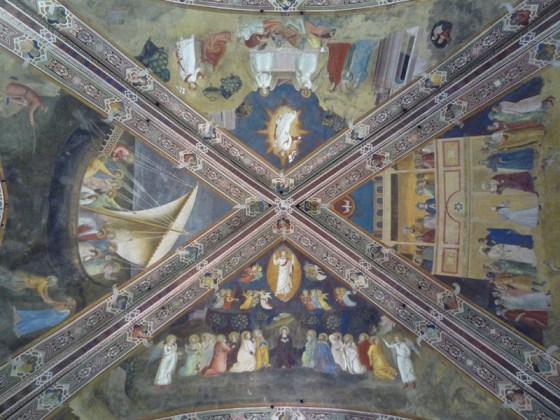Annexed to the church of Santa Maria Novella in Florence is a large frescoed chapter house that is one of the most impressive surviving testimonies of the 1360s in Florence. Erroneously named the “Spanish Chapel” because of its later use for prayer by Spanish colonists, the structure (built probably in the 1350s) in fact served as the chapter house for the Dominican friars of SMN. The chapter house also had an altar and a burial function for its patron Buonamico di Lapo Guidalotti, who paid the painter Andrea di Bonaiuto (Andrea di Firenze) to work on it from 1366-8.

The low vaulted space is entirely frescoed. The flat space of the large lunettes under the vault are not divided up in any way, but contain complex allegories, or in the case of the altar wall, a continuous narrative. The frescoes in the altar area are 16th-century; on the ground is the original patron’s tomb and other, later, marble tomb markers. The earlier scenes by Andrea di Firenze are: (1) altar wall, way to calvalry, crucifixion, descent into limbo; (2) left wall, the Triumph of St. Thomas Aquinas; and (3) right wall, the triumph of the church or the way to salvation. On the back (entrance) wall are ruined scenes from the life of Saint Peter Martyr (he was also a Dominican). The vault contains, above the altar wall, the Resurrection and the Ascension of Christ above the back wall; above the side walls the vault shows the Pentecost and the Navicella. These two last vault sections are considered biblical precedents to the contemporary material presented on the lower walls.

The overall theme of this space is salvation through Christ, and with the aid of the Dominicans. This is why, on the right wall, you see black-and-white clothed Dominicans preaching, instructing from books, and literally leading people by the hand through a torturous road that works upwards on the right hand side of the wall, towards heaven which is depicted as a gate at the top. Peter, holding his key to the gate, looks sternly at the new initiates to heaven with a face that seems to say “You just barely made it.”
Across from this wall you have a summary of medieval, and particularly Dominican, education, with Saint Thomas Aquinas in the center demonstrating his Summa Teologica and crushing heretics at his feet. The scenes of crucifixion and resurrection, on the other hand, relate more to the chapel’s burial function and signify belief in the afterlife and hope of salvation for the patron.

I think this is one of the most exciting frescoes in the city. Usually taught as evidence of a depressed era in the wake of the black plague of 1348, the paintings have a lot more to them. Numerous fascinating details show a wide range of facial types – images of “infidels” (non-Christians) make for particularly interesting caricatures. The bright, jewel-toned colour scheme is an appetizing and welcome break from the naturalism of 50 years earlier. The massive decorative banding that divides the scenes is worthy of study in itself. And the logic of its organization – surely coached by a Dominican advisor – is unchallengeable.
Hardly a throwback to the era pre-Giotto, the Spanish Chapel is a masterpiece of its time.








Sign up to receive future blog posts by email
Alexandra Korey
Alexandra Korey aka @arttrav on social media, is a Florence-based writer and digital consultant. Her blog, ArtTrav has been online since 2004.
Related Posts
January 30, 2024
Florence Museum News 2024
January 5, 2024
The Architecture of Michelangelo’s Laurentian Library
July 19, 2023




